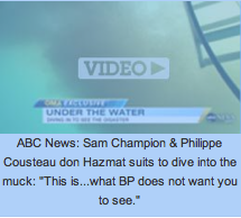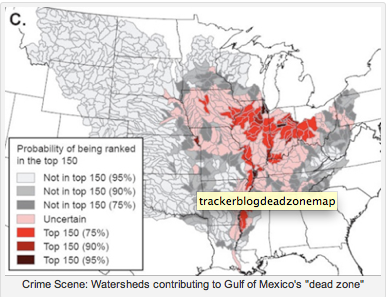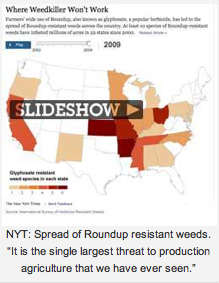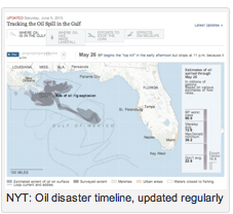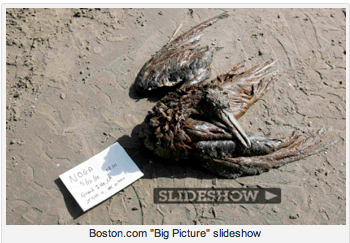From the first, almost cheerfully do-able estimate of 1,000 barrels of oil spewing daily into the Gulf of Mexico to a…
- jaw-dropping 5,000 barrel revision
- horrifying 19,000 barrel update
- are-you-kidding-me? 25,000 barrel recalculation
- and an it’s way-way-way-more-than-the-Exxon-Valdez admission
Dispersants that present environmental issues of their own have only made the situation more complex. “We’re dealing with an aggregation of hundreds of thousands of patches of oil,” according to Admiral Thad W. Allen, the Coast Guard commander in charge of the clean-up. It will takes months to scrub the surface. Years at least to scrub the wetlands.
Specialized oil-loving microbes – either naturally occurring or lab-concocted – work slowly, especially in cold or low-oxygen waters. They also give off CO2 in the process, adding their microbial 2 cents to ocean acidification, and soak of oxygen, potentially to the point where nothing can survive: a Silent Spring beneath the waves.
THE DEAD ZONE
The BP geyser isn’t the biggest (at least for now) or even the longest-running oil-driven disaster in the Gulf. For over 60 years, chemical fertilizer-laced farm run-off has flowed into the Mississippi, then down to the Gulf where it annually triggers massive algal blooms, followed by equally massive algal die-offs. Microbes on decomposition duty soak up so much oxygen over an area averaging 6,000 square miles, the water turns into a lethal “dead zone.” (the size of the zone depends on a variety of factors, including which way the wind blows).
Writer Michael Pollan has spent a career tallying the costs of an agricultural system tipped so far out balance, there is almost nothing natural about it. Short term gains, measured in bountiful harvests and weed-free fields, have collectively blinded us to the full costs, unsustainability and sheer craziness of it all:
From the standpoint of industrial efficiency, it’s too bad we can’t simply drink petroleum directly, because there’s a lot less energy in a bushel of corn (measured in calories) than there is in the half-gallon of oil required to produce it. Ecologically, this is a fabulously expensive way to produce food–but “ecologically” is no longer the operative standard. In the factory, time is money, and yield is everything.
- What’s Eating America
But the end of the era of easy bushel-busting gains may be over. All around us, the “ag bubble” is deflating. Fertilizer isn’t the only thing coursing down the nation’s waterways. So is topsoil. By the ton. And the more topsoil that’s lost, the more dependent crops become on fertilizer, which means the more dependent they become on…oil.
NYT: Spread of Roundup resistant weeds. “It is the single largest threat to production agriculture that we have ever seen.”
Monsanto’s Roundup Ready seeds were sold, in part, as a way to reduce topsoil erosion. The genetically modified seeds were designed (and patented, but that’s another story) to be impervious to the company’s proprietary herbicide, Roundup. Farmers could stop tilling the soil – reducing erosion – and simply spray their weed-troubles away. Man-engineered genetic selection, however, turned out to be no match for the old-fashioned natural kind. Roundup-defiant “superweeds” have now invaded millions of acres in the U.S. and they are just warming up.
Since petrochemicals are ingredients in herbicides and pesticides, the more crops need to be treated, the more dependent they become on…oil.
ENGULFED
Back in the Gulf, the magnitude of the devastation caused by a hole in the sea floor roughly the size of sewer cover goes beyond words, and even beyond maps. The now iconic New York Timesinfographic, updated regularly and viewable as a disturbingly long, mesmerizing time animation, only shows the story on the surface. Data are harder to come by for the deeper story, and what little is known isn’t encouraging.
The damage isn’t confined to water and wetlands, or even to a region. Migrating birds, including those currently nesting in blissful ignorance in my Chicago neighborhood and as far away as the Canadian arctic, will find themselves in harm’s way when they fly south again for the winter.
The entire planet could feel the effects. New research suggests that marine dead zones can trigger an an increase in the amount of nitrous oxide filtering into the atmosphere. That might be kind of funny – it’s laughing gas – except that N2O, per unit weight, is nearly 300 times as potent a greenhouse gas as CO2. It also contributes to the development of the ozone hole, increasing the planet’s exposure to UV light. So, more climate change and skin cancer. Great. Just great…
WHATEVER IT TAKES – WHATEVER THAT IS
Skimming, burning, setting booms around hundreds of miles of coastline, dredging insti-sand berm islands, collecting the hairy/furry leftovers from nation’s hair-cuts and pet trims to make oil-absorbant materials, spreading hay across the water’s surface – in the face of such overwhelming disaster, the only right answer is “all of the above.” (And if all else fails, there is always “Stephen Colbert’s Oil Containment Solution Randomizer.”)
But only microbes have what it takes to break apart oil and get things back on ecological track.
Communities of naturally-occurring microbes, evolved to dine on oil burbling up from natural seeps (of which there are many across the world’s oceans), have, so far, proven more effective than any microbes developed in the lab. “A superbug fails because it competes with this community that is adapted to the environment,” notes Ron Atlas, a microbiologist who worked on the Exxon-Valdez spill and has co-written one of the definitive books on the subject, Bioremediation.
That hasn’t stopped researchers from trying, yet even GMO bugs need a dollop of nitrogen and phosphorous – the same ingredients found in the fertilized run-off behind the Gulf’s dead zone – to pick up their naturally slow pace. Getting it to them in the middle of the open ocean isn’t so easy.
Enter NASA.
In 1992, a failed attempt to create liquid crystals in zero gravity led to the discovery of microspheres, bubbles of gas trapped in tiny crystalline structures. NASA Tech Hall of Famer, Petroleum Remediation Product (PRP) is based on this technology and designed to soak up oil spills. The sphere-lettes, less than 100 microns across, are made of beeswax, which is naturally full of nitrogen, phosphorous and potassium. Beeswax is also oleophilic, which means it binds with oil. PRP has been used to clean up everything from boat bilges to driveway stains. Once the oil is gone, PRP biodegrades and that’s that.
| |
THE NETWORK
Although humans may not be able to plug into the planet Earth as literally as the Na’vi on Pandora in Avatar, we are as inextricably linked to greater whole. The oil spill in the Gulf brings this into sharp focus. There is no escape: what goes around, comes around.
Have we reached a point where the resilience of the planet’s network of elegantly interlaced ecosystems has been stretched to the limit? In a few short centuries, we have taken a good deal of the “bounce” out of the system And once tipping points start to collide, there is no predicting what could happen next.
Perhaps – finally – this is the “teachable moment” where something actually gets learned. In one form or another, fossil fuel plays a part in every one of these grim scenarios. There are alternatives. Yet somehow those greener, smarter, environmentally-friendlier, job-creating technologies only seem to get hauled out for display on Earth Day, World Environment Day, or during political campaigns to give us all a rosy glow about the promise of brighter tomorrow.
Even BP had hung its corporate hat (top hat?) on a greener, cleaner future, spending millions of dollars on a sunny logo and a “beyond petroleum” ad campaign.
Well, yes, now that you mention it, I would like a world beyond petroleum.
As soon as possible.
- Interview with Philippe Cousteau / Diving into the Spill: Today Show (video)
- “Oil plumes, Gulf’s unseen disaster”: Rachel Maddow interview with Samatha Joye (video)
- “What the Spill Will Kill”: Sharon Begley / Newsweek
- “Slick Solution: How Microbes Will Clean Up the Deepwater Horizon Oil Spill”: David Biello / Scientific American
- “Small Things: First Responders to Oil Spills”: D. Jay Grimes & Ronald M. Atlas / Small Things Considered / ASM blog
- “Bangor Scientists’ Plan to Clean Up Oil Spills”: BBC (print / video)
- “How Long Will the Spill in the Gulf of Mexico Last?”: David Biello / Scientific American
- “Despite promises to fix it, the Gulf’s dead zone is growing”: Bruce Eggler /Times-Picayune
- “Dead Zone Study”: KRIS TV (video)
- “The Omnivore’s Dilemma”: Michael Pollan (book)
- “The lowdown on topsoil: It’s disappearing”: Tom Paulson, Seattle Post-Intelligencer
- “The Vanishing of the Bees”: documentary trailer (video)
- “Dennis vanEngelsdorp: a plea for bees”: TED partner series (video)
- “High Levels of Miticides and Agrochemicals in North American Apiaries: Implications for Hony Bee Health”: PLoS One (research paper)
- “Beyond Propaganda”: John Kenney, New York Times (op-ed)
- “Gulf Pipelines Face Damage as Gulf Eats Oil Marshes?”: Christine Dell’Amore, National Geographic News
- Reinventing Fire: Rocky Mountain Institute initiative


